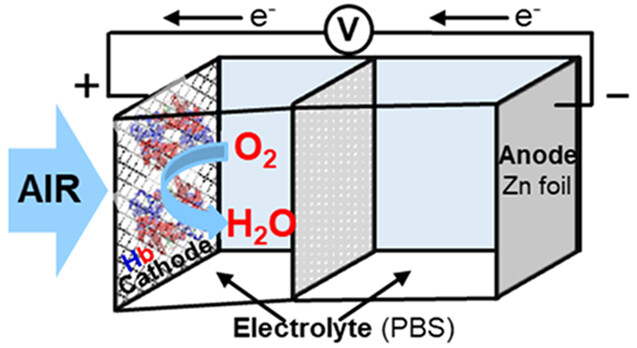Scientists at the University of Córdoba in Spain have come up with a way of incorporating hemoglobin – the key component of red blood cells – into a battery, creating a prototype that kept working for between 20 and 30 days.
Zinc-air batteries are one of the most sustainable alternatives we have to the ubiquitous lithium-ion batteries that already power everything from laptops to electric vehicles. They work via a chemical reaction called the oxygen reduction reaction. As air is pulled into the battery, oxygen is reduced to water at the cathode (the positive end), releasing electrodes that oxidize zinc at the anode (negative end).
To keep that reaction going, you need a good catalyst, with some very specific properties. Properties, the researchers realized, that hemoglobin certainly has. “To be a good catalyst in the oxygen reduction reaction, the catalyst has to have two properties: it needs to quickly absorb oxygen molecules, and form water molecules relatively easily,” explained senior author Manuel Cano Luna in a statement. “And hemoglobin met those requirements.”

This diagram illustrates how the battery works.
Hemoglobin is the protein that gives red blood cells both their characteristic hue and their oxygen-carrying ability. It’s fundamental to how our bodies work, and it turned out to be pretty impressive in the battery as well: just 0.165 milligrams of hemoglobin kept it alive for 20-30 days.
The researchers say that using a biocompatible catalyst like this could be key if these batteries are to be used in devices that are implanted inside the body, such as pacemakers. The battery works at pH 7.4, which is very similar to the pH of blood. The possibilities could extend beyond humans too, since hemoglobin analogs are present in many mammals.
There are still some things to perfect, however. The biggest issue at the moment is that the prototype is not rechargeable, so the team is searching for a protein that might be able to transform water back into oxygen and start the reaction cycle again from the beginning. The fact it needs oxygen at all is another limitation, meaning these sorts of batteries won’t be usable for applications in space.
But it’s still a fascinating possibility. Energy storage remains a major hurdle in humanity’s quest to move towards a more sustainable future. Batteries are improving all the time. While lithium-ion batteries are undoubtedly an important part of that story, issues around mining enough lithium and the waste they generate mean that there’s room for other options.
A biocompatible hemoglobin-based battery might just be one of them.
The study is published in the journal Energy & Fuels.
Source Link: “Blood Battery” Prototype Powered By Hemoglobin Unveiled In World First